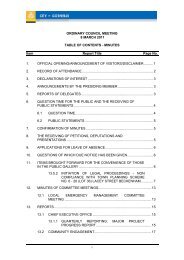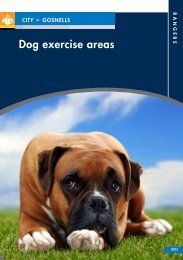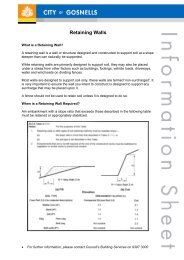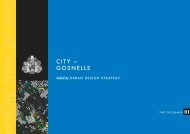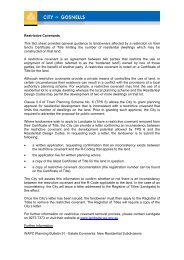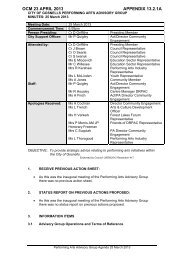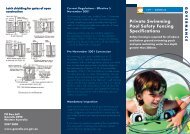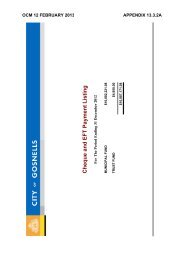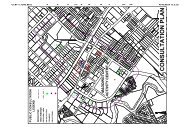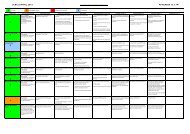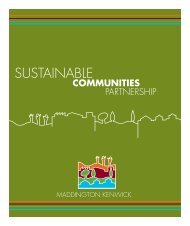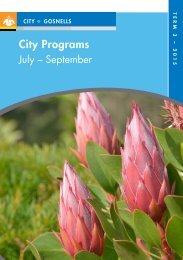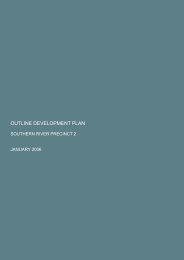Summary - City of Gosnells
Summary - City of Gosnells
Summary - City of Gosnells
You also want an ePaper? Increase the reach of your titles
YUMPU automatically turns print PDFs into web optimized ePapers that Google loves.
Regional Setting 13(Keighery and Trudgen, 1992; Government <strong>of</strong> Western Australia, 2000a). These areas are specificallyprotected by the Bush Forever policy (Government <strong>of</strong> Western Australia, 2000a, p. xiv) that states:‘There will be a general presumption against clearing bushland containing threatened ecologicalcommunities or representation <strong>of</strong> vegetation complexes <strong>of</strong> which less than 10 per cent currentlyremains on the Swan Coastal Plain portion <strong>of</strong> the Perth Metropolitan Region (generally involving theeastern side <strong>of</strong> the Swan Coastal Plain).’Bush Forever Site 387 (The Greater Brixton Street Wetlands) is the most species-rich area <strong>of</strong> all the BushForever sites described in the Bush Forever report (Government <strong>of</strong> Western Australia, 2000a, 2000b) and, assuch, is one <strong>of</strong> the most important conservation reserves in the Swan Coastal Plain Bioregion <strong>of</strong> WesternAustralia. Currently more than 555 native plant taxa are known from the 127 ha <strong>of</strong> the Greater Brixton StreetWetlands (Keighery and Keighery, 2000). This represents over 26% <strong>of</strong> the total native flora <strong>of</strong> the PerthFloristic District, about 20% <strong>of</strong> the total native flora <strong>of</strong> the species-rich Swan Coastal Plain (SCP) Bioregionand about 12% <strong>of</strong> the total native flora <strong>of</strong> the South West Australian Botanical Province (the latter area beingthe only globally-significant biodiversity ‘hot spot’ in Australia) (Conservation International, 2008; WesternAustralian Herbarium, 2009). The Greater Brixton Street Wetlands contain nearly five times the speciesrichness<strong>of</strong> native flora per unit area that is found in Kings Park, which has only 293 native taxa in 321 ha <strong>of</strong>bushland according to Government <strong>of</strong> Western Australia (2000b). Factors that are likely to have contributedto the very high biodiversity values exhibited in remnant bush and wetlands in the vicinity <strong>of</strong> the GreaterBrixton Street Wetlands include:• The great habitat heterogeneity provided by the complex hydrogeology in the alluvial fans <strong>of</strong> the PinjarraPlain (V & C Semeniuk Research Group, 2001);• The inclusion, in BFS 387, <strong>of</strong> a substantial sample <strong>of</strong> the topographical series <strong>of</strong> landforms and soils(catena) that occur within the Wattle Grove-Kenwick alluvial fan (due to the orientation <strong>of</strong> this BushForever Site parallel to the topographical gradient down the alluvial fan - Figure 7);• The very species-rich pool <strong>of</strong> flora available in the southwest Western Australia Floristic Province thatwas available to colonise the ESCP via the natural corridors; and• The repeated fluctuations in climatic and edaphic conditions that were experienced in the region duringthe Quaternary era. Whilst there was good connectivity between the habitats <strong>of</strong> the ESCP and the DarlingRange and its hinterland, plants adapted to both semi-arid and humid conditions were able to colonise theESCP during climatic fluctuations. This connectivity <strong>of</strong> habitats between the Darling Range and theCanning River along the Yule Brook is still functioning currently to a certain extent.2.6.1 Regional Scale Vegetation Units <strong>of</strong> the Eastern Swan Coastal PlainThere have been numerous studies that have aimed to characterise, classify and/or map the vegetation unitsthat are present within the Swan Coastal Plain Bioregion to investigate the land-use capability <strong>of</strong> land thatwas covered with the native vegetation and to assess the conservation significance and reservation status <strong>of</strong>this vegetation. The terms Vegetation Systems, Vegetation Complexes and Vegetation Associations havebeen used by various authors to designate vegetation units mapped at various scales. All <strong>of</strong> these units areregional scale, high order units.2.6.1.1 Vegetation Systems (Beard, 1979a)Beard (1979a, 1979b, 1981) mapped the vegetation <strong>of</strong> the Swan Coastal Plain as broadscale VegetationSystems based on the structures <strong>of</strong> the dominant vegetation layers. In this mapping, the vegetation <strong>of</strong> most <strong>of</strong>the MKSEA and neighbouring area is indicated as Marri (Corymbia calophylla) Woodland (e 3 Mi), <strong>of</strong> thePinjarra Plain Vegetation System (as defined by Smith 1974). Beard’s Pinjarra Plain Vegetation Systemextended from about Gingin to Dunsborough and was located between the Bassendean Vegetation System tothe west and the Ridge Hill Shelf Vegetation System to the east. The Pinjarra Plain Vegetation Systeminhabited the most fertile soils <strong>of</strong> the coastal plain, which were preferentially developed for pasture andirrigation systems. Because Beard (1979a) considered that very little (if any) virgin Marri Woodland <strong>of</strong> theTauss, C. and Weston, A.S. (2010). The flora, vegetation and wetlands <strong>of</strong> the Maddington-Kenwick Strategic Employment Area.A survey <strong>of</strong> the rural lands in the vicinity <strong>of</strong> the Greater Brixton Street Wetlands. Report to the <strong>City</strong> <strong>of</strong> <strong>Gosnells</strong>, W.A. Version 18.04.10



